Text
Reflections from User Research

Over the last few weeks, I have been talking to a lot of educators and students. Based off of those conversations, I updated my user journies and created a breakdown below of what I learned structured in the 5 E's.
Updated Journey Maps

Entice
Students find out from their friends, social media, teachers, and councilors about the groups that they are interested in and who is out doing great work
Peer pressure works
Students are attracted to opportunities where they can express themselves, step into leadership positions, and show what they can do on their own.
The look/feel is really important. It doesn't need to feel like a Demi Lovato single - it should feel more like Lorde - quirky, energetic, professional, yet slightly anarchist
Students get news and what is going on in the world in a visual way. Instagram and memes allow for quick, humorous (if need be) dissemination of information. They are conversation starters.
A useful pitch to orgs could be for when they are planning an event or already have a specific goal in mind. They know that they should come up with goals and ideas on how to achieve them through tactics.
Enter
Student-org meetings are probably going to be the most natural way to talk to students about the project.
This should be focused on conversation and examples. The examples provided are a good place to start. Then asking about examples that students have seen or used in the past.
The define/ideate/create goal needs more clarification
Instructions need to be given in a way that either asks them to teach others how to achieve the goal or to help themselves. Doing both may be confusing.
Videos are going to be really helpful here
Is the repository and creation tool enough?
What does the visual design need to look like? What does the language need to feel like? Who should create the language?
Engage
I feel like the rest of this process is a co-creation process. Perhaps part of my thesis is just an exploration of how things can be co-created with teens instead of for them. Engaging them in the creation is just as important as the engagement in the thing afterward.
This engagement has multiple layers - that might need to be simplified. The engagement changes depending on the setting in which students engage with it and their experience with activism beforehand. Those with less experience will be more interested in looking at examples while those with more experience will be more comfortable creating and contributing their own content.
In that same vein, students who are more confident are probably already involved in student groups or doing their own thing. This means that it makes sense to engage groups in the creation of content and provide support for students to get connected to them. The goal may not be for students to create their own orgs, but to connect with existing ones. Students who start their own thing are probably outliers, but designing opportunities for them to believe that they can is a great step on the way there.
Encouragement is essential to get students to take that first step and to keep coming back. Building in mechanisms for encouragement will keep students building momentum. When students are interacting with each other in person this happens naturally. Maybe there are ways to provide more of this in a digital way?
Encouragement can come in the form of shout-outs - doesn't have to only be immediate.
Engagement happens in many places and many ways. One place in the engagement part of this that I need to think more about is the content upload piece. How do students
Exit
There are a lot of ways you could exit an interaction with OCS. In the co-creation/workshop phase, the exit is the summary of your experience - what you learned/what surprised you and the rose/bud/thorn exercise. These work really well because they are conversational
Online the exit could also be conversational - one last question maybe? Either way, when you submit the form there should be a summarizing opportunity - This should be beyond a thank you. Maybe showing similar suggestions or next steps. I'm not sure how to do this yet.
The other thing that needs to be thought about here is what the exit experience might be for the students and educators who just come to the site to peruse ideas. Should they be able to print them? What should they be able to download? What should they be able to edit? Could there be an app?
Extend
The monthly themes are a great way to extend the experience and keep people coming back. Knowing that they are going to be featured and are part of a larger community will help.
The experience will naturally be extended if chapter organizations use the framework multiple times when they are planning new events or engagements.
Perhaps there could be a way to get notified weekly or monthly about the new additions to the platform or when new chapters join <--- what should new chapters get?
Other ways to extend could be updates after an original feature. Maybe chapters could give monthly updates?
Social media is an obvious way to extend the experience - I will need to ask students for ideas around this!
Maybe I can extend the experience by working with student outlets like ForthWrite to highlight work and recruit more students.
Other thoughts:
There is still a lot going on. What can I cut back?
I need to update my dock to make clear what is short term vs long term visit
I can co-create the content on the site while getting feedback on it.
I need to explore different ways to upload ideas - how can I make this stupid simple?
0 notes
Text
User Testing and Feedback Planning

I have incorporated user feedback many times throughout the process of creating Our Collective Story. This post is an overview of how I plan to do user testing and what I have done so far. Most recently, this led to some big pivots in the project.
The user testing and feedback that I have gotten so far:
workshop at Great Oaks
conversations with student activists online
Feedback from Shaktii at YaYa
Feedback from Hannah and MC
Plan for user testing:
Pizza party tomorrow
Work with #TeensTakeCharge
Table at Integrate NYC on 3/23
Table at NPL on 3/29
Hopefully meet with YaYa students in next few weeks
Work with Great Oaks students (date TBD)
Continue to feedback from students online (Ongoing)
Get feedback from Integrate student leaders (date TBD)
How I will test:
Having them go through the concept/mockups and ask questions about how they would use it
Ask students to create activities for the collection
Workshops
Tables at activism meetings and youth gatherings
How I will record/capture:
Take pictures/video whenever possible
Have students/educators create activities - capture these
Have students/educators take pictures of themselves and share with me if I can't take pictures of them
Audio record
Written reflections
Maybe a survey?
Top things I want to know:
What issues do they care about?
How did they get involved in the activities/causes?
Who do they act with? How do they organize amongst themselves?
What mediums are they excited about?
What lessons have they learned that they could teach others?
How would they use this?
What is the best way to make the ask online to help generate activities?
How would they want to share what they create?
I have done some testing so far - lessons learned will come in the next post!
0 notes
Text
Who is the "We"?

"How Might We" is a phrase that might as well be in the UX/Interaction Design Bible. It's touted as the "magic phrase" that all good designers use to turn their challenge statements into questions.
I remember learning about it as a pivotal ah-ha moment. Well, while meeting with my thesis advisor Mari Nakano this week I had another ah-ha moment when she asked:
"Who is the 'we' in your 'How might we' question?"
BAM.
Mic drop.
It seems super obvious that you should know who the "we" is in the HMW question, but I had never thought of that as important. I had been trained to just mindlessly write HMW in front of everything. This, in turn, created a major ego check.
Was the "we" just "me"?
As a designer I want my work to be collaborative if not co-created. I believe that users should drive solutions, not designers. I talk a lot about the idea of by who, for who. To be a "designer" you have to have an ego, but I had never seen how ego was built into the way we ideate.
If designers don't ask who the "we" is in our HMW then we are building in the assumption that we are at the center of the solution.
Reworking my HMW
During our conversation, Mari encouraged me to spend time refining my HMW statement. In the spirit of transparency and showing my own learning, here's how I applied this new perspective:
The original HMW (admittedly in super-draft form):
How might we utilize digital platforms as educational tools that foster, support, and amplify student voices?
I first tried by subbing out the "we" with the name of my project:
How might Our Collective Story provide resources for youth ages 13-19 to tell stories about the issues they care about?
How might Our Collective Story make digital storytelling accessible for students ages 13-19 to help them organize around the issues they care about?
How might Our Collective Story help students ages 13-19 organize around the issues they care about using digital storytelling?
How might Our Collective Story help students (ages 13-19) raise awareness around the issues they care about?
Then came the turning point:
How might Our Collective Story be student-led?
Suddenly I realized that subbing out the name of my project for "we" was basically the same thing. If I wanted this to be student-led, to be truly focused on them, then they should be the "we." Our Collective Story should just be the tool.
Here's my latest version:
How might youth (ages 13-19) use digital storytelling to discuss and drive action around the issues they care about?
This is much better. This is about students, about youth, and not about me.
Thanks to Mari for pushing me to think beyond the cookie-cutter HMW sentence starter. From now on I will think of the phrase as HM_.
1 note
·
View note
Text
Defining Competitors + Updating My Value Statement

On my plane ride back from France I started working on brainstorming organizations and products similar to mine and making lists of what they do well and what they don't. In class, I had a chance to turn that list into a matrix and get feedback on it from Amsha and Christine. Even with the large pivot in my project, these lists still stand.
After doing the pencil version, I pulled out the common things that competitors did right versus wrong and used them to create feature categories in the digital version. After my initial brainstorm, I had 14 different organizations and 21 different features. To make the matrix anywhere close to helpful, I needed to focus on on the core features. I also color coded the competitors by out of school, after school, and in the classroom.

After sorting through the list, a few features and competitors popped out as extra important to focus on. The key features that allow for differentiation are:
Focus on storytelling vs. government process
Digital media is a core focus
Long-term Commitment
Goal of generating action
Flexible implementation (vs. prescribed)
Closest competitors to what I am doing are:
Generation Citizen
Student Newspaper
Iterations on Value Proposition
With all of the updates recently I needed to update my value proposition.
Old value proposition:
Connected Collective is a flexible civic activism curriculum that utilizes social media to help 8th-12th-grade students discuss the ways their personal experiences are impacted by local policies. Unlike other programs that haven’t been updated for the digital age, Connected Collective uses storytelling to empower students to organize their friends and family online.
New value proposition:
Throughout history, students have lead the way on many social justice issues, yet the way we teach them to engage has not kept up with the times.
Our Collective Story is a flexible activity toolkit for 8th- to 12th-grade educators. By incorporating digital media and social justice education, students explore digital mediums while learning to be investigators and advocates when it comes to the ways policies affect their lives.
Side note: I'm still not sure how I feel about the word "toolkit" still, but it is much closer to what this is than a curriculum.
0 notes
Text
It's Not a Solution, It's a Spectrum, It's a System, It's a...
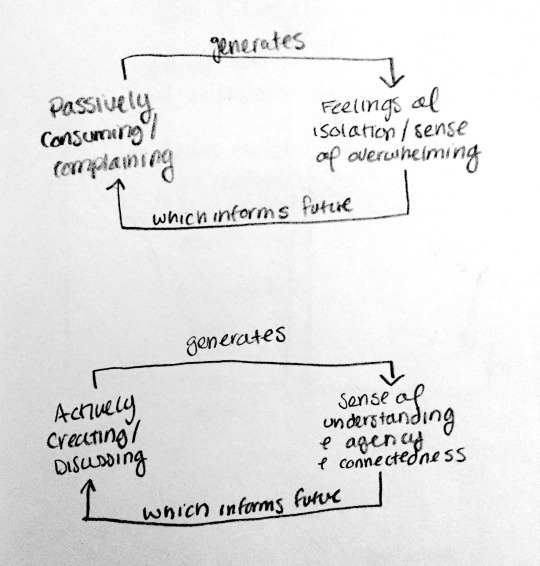
It's been a crazy few weeks. I took part in the Student Design Challenge at the Interaction '18 conference and hit a few big challenges as I jumped back into my thesis. Stepping away from my project for the conference was really helpful, as was some blunt advice from Mari, my thesis advisor. Here are the big things I've learned (or at least internalized) over the past week.

1. Design for the human motivation.
One of the biggest tools that I will take away from the workshop and materials from Margaret Price, who works on Inclusive Design at Microsoft, during the student design challenge was the concept of designing with a spectrum in mind. Their Persona Spectrum spits out permanent, situational, and temporary disabilities and shows how a design for a permanent disability can solve for a wide number of people. The spectrum challenges the idea of the ideal user and the ideal usage.
Instead of focusing on the product, it puts the focus on the human motivation.
When it comes to applying this to my thesis, while I am not specifically designing for users with disabilities, I do need to keep in mind a spectrum of uses. This is still crystallizing, but I was reminded to go back to my own motivations for working on the project and the motivations of students and teachers who will be using it. In order to do this, I went back to testimonials from Girl Represent.
"It was great to see the young woman I was working with embrace the fact that she could make a change right now with the resources she already has!"
"Each young lady learned to tap into their own potential and create real solutions to issues they see in their daily lives."
Even though I am working on a very different iteration, the core motivation of my work hasn't changed. We all see things in our daily lives that we want to change, but despite the fact that we have talents and tiny miracle computers in our hands, we often fall into the trap of thinking that there isn't anything we can do about them. This is especially true for students who don't have a vote and are often seen as too immature to understand and contribute, but we all want to make a meaningful contribution to the causes we care about.

2. Look for adaptations.
Looking for adaptations has long been a best practice of design research, but this was brought into a new light over the last week. One of the big pieces of the Inclusive Design guide is the idea that disability isn't inherently linked to physical or mental ability, rather it is a mismatch between a human motivation and their environment.
Under this definition, not being able to make a meaningful contribution to the causes we care about because our environments aren't set up for it would qualify as a disability. This mismatch partially happens because our systems of engagement are outdated (do petitions really make sense anymore?), but it largely happens by design. As Layla Acaroglu put it in her Interaction '18 talk, we have created systems of disengagement.
With this lens, what are the adaptations that people have made to deal with the fact that it is unclear how to make meaningful contributions? Protest, social media venting, and some community activism (but not as much of this has been sustained). These have become the tools of choice because old methods of attending community meetings, calling on representatives, and creating petitions have been made either incredibly difficult to do or made to feel ineffective (once again, nobody understands petitions). Almost all of these things take advantage of the magic of digital media and/or the power we hold in our cell phones. These are the adaptations that should inform my thesis.

3. Make it Modular: Design for a Spectrum of Uses
One of my other big takeaways from the week was that I need to design for a spectrum of uses. The combination of hearing from Josh Clark and from Mari Nakano, my thesis advisor this week challenged me to see the big places I was getting stuck. I have always had the goal of enabling students to share their experiences and tell their own stories, but I kept falling into the trap of focusing on the act of creating grand result as the only way to get value from my project. As a systems thinker, I tend to design solutions that move all the way through a process to the big picture impact, but sometimes I forget that the value for the user actually lies in the process, not the outcome.
When I saw my list of goals and activities sitting on the table in front of Mari, suddenly my frustrations about forcing them all to fit together sequentially seemed futile - in a good way. She suggested that perhaps I focus on the process of collaboration and co-creation with teachers and between students. Where there ways that I could enable teachers to create their own lessons? Where there different mediums I could use to facilitate the different ways teachers and students might access the information? An editable word doc vs. a handy binder? How could it be a deck of cards or a website?
Mari suggested the metaphor of a cookbook. How could I provide a set of recipes that users could take, modify, combine in the way they wanted to, and share with others? When suggesting that I map out a Plan A and Plan B, she prompted me to focus on the usability rather than the results.
This prompted me to look at how I can break apart the curriculum/toolkit I have created into individual activities that all have meaningful outputs. The activities can be combined into sets to create larger outputs, but the goal isn't for every student to create a mindblowing podcast that will be saved forever, it is for them to feel like they can make a meaningful contribution to a cause they care about with the tools they already have. Based on my research, it is that feeling over time with little actions that develop the confidence to take larger actions. Therefore, I also need to explore ways to mark the achievement.
A spectrum of uses could mean how often users interact, how long they interact, how experienced they are with the subject, and their different passions and interests. No matter what lense students and teachers are coming from, they should be able to engage in a meaningful way. They shouldn't be required to fit into my idealized version of the digital media savvy student/teacher activist. I can't even model that myself.

4. I'm not teaching students to be activists. I'm teaching them to be researchers.
In the fall I put the breaks on creating tools to amplify student voice in the classroom because I didn't want to pretend to be able to teach teachers how to do their jobs. After that realization, multiple people when giving me feedback would ask me what I brought to the table that teachers weren't already good at. I have had a hard time answering that question. I'm not an activist. I'm not a photographer. I'm not a producer or a politician. But I am a scrappy, research-loving, designer. I'm actually pretty good at that. That is what I can bring to the party.
So, my project is no longer about learning how to create something grand. It's about the things you can do every day, with the tools you already have, to create a meaningful impact on your community. It's about understanding that you already have everything you need to be a changemaker. It's about viewing yourself in a new light.
1 note
·
View note
Text
Not Everyone Needs to Run a 5K

This morning in Zeldman's "Selling Design" class we heard from Josh Clark. Josh has done a lot of notable things throughout his career and the conversation was informing overall, but there was one comment that he said in passing that really stuck with me.
In 1996, Josh created the Couch to 5K running program. C25K was based on the idea that people get turned off of running because they go too hard, too fast. Their bodies don't have time to adjust. Instead, C25k eases people into running by alternating between walking and running for 30 minutes three times a week over the course of 8 weeks. By the ninth week, if they have followed the course, participants should be able to run a 5K without stopping.
According to C25kfree.com, the program has helped millions get into shape. What started as a simple schedule grew into a website, a podcast, an app, and a community. Josh barely talked about this success in class. What he did say about it was that it was a catalyst to a career creating systems that people can use to become the things they want to be. To unlock creativity, to be more healthy, to be more productive. He didn't say it, but what I got out of it was that C25K was never about everyone running a 5K. That stuck with me as a challenge for my thesis.
One of the big things I've been wrestling with is, in short, trying to get all participants to run a 5K. In Code Switch Club students created videos. In the most recent version of The Collective Project, I had students creating podcasts that would be amplified by a media outlet or stored at the library. In my mind, the value was in getting everyone to run a 5K, but that line of thinking was causing me to totally miss the opportunities to create valuable interactions for those who may just pick my project up casually, use it for a day, and then keep moving.
I don't know the stats on the number of people who actually complete C25K, but I am willing to bet that it is actually pretty low. However, I am also willing to bet that most of the people who don't make it still get a lot of value out of the program. They don't have to run a 5K to be a healthier version of themselves, so I shouldn't assume that I have to make students and educators run one to be more informed, engaged versions of themselves.
2 notes
·
View notes
Text
Final Prototyping Plan

The end is near! Frighteningly near. But don't worry. I have a plan... or at least version 1 of a plan.
What is this thing?
The Collective Project (TCP) is a civic-engagement curriculum for the digital age designed to move 8th-12th graders along the path to from passive observance to active civic and political engagement.
Using audio and social media as mediums, students learn how to use storytelling and sharing to understand and affect social change. TCP consists of five stages that have been designed as a starter kit for educators to either use as is or customize. Each stage has at least one lesson. The lessons were designed with a 45-minute class period in mind but can be easily condensed or expanded to fit well in any class at least 30 minutes in length.
My prototype will include:
A downloadable curriculum set that has been tested with teachers and students.
A website that allows educators to view what others have done with The Collective Project and add their own lessons to the curriculum.
This is viable because...
We are in a new age. Today’s students are more connected, more diverse, and more entrepreneurial than generations before them. They are digital natives who form their identities by connecting with others around common causes. Movements like #blacklivesmatter and #metoo that are born online shape public opinion and spur public and political action. They bring light to toxic and systemic policies and offer access to the civic and political process to those who have traditionally been underrepresented. More importantly, they have sparked conversations around the values that we share and what we owe one another as citizens.
The Collective Project is based on the idea that there are stages of political engagement that revolve around dialogue. I believe two big shifts students can make in becoming civically engaged happen when they start talking about how they are personally affected by policies and start having that conversation with their community. A third is when they find something they share with a community leader that enables them to envision a similar path for themselves. TCP aims to
Timeline:

0 notes
Text
Mapping and Road Mapping
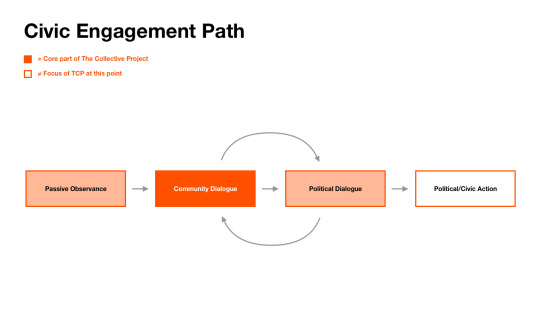
During my first few meetings with my thesis advisor, Mari Nakano, we have focused on putting my thesis in context within the problem space I am tackling. I wrote previously about how Mari made a point about how many designers try to tackle a huge problem all at once and have an issue breaking it down into bite-size pieces that they can iterate on. She suggested that I map out the larger goal that my project fits into and show what piece I am focusing on to help me focus and ensure we were both talking about the same thing. Below are the maps that came out of this exercise and a roadmap to get to the end of the semester.
Intention Mapping
I just came up with this term, but I am calling this my intention map. It shows the ultimate goal I am working on and the parts of it that I am choosing to focus on versus the pieces that are part of the larger goal. Making this map helped me see which ideas and pieces of research I needed to focus on and which pieces I could table for later because they aren't part of this specific project.
I reviewed this map with Mari at our last meeting and she suggested two things (I've already done one of them):
The next step I take should be outlining everything I know about the orange boxes.
I should find a partner to help amplify the stories and focus on creating the container/environment that fosters sharing.

Journey Mapping
Mari also challenged me to make a journey map of how my users (teachers and students) would interact with my project. I posted the sketch version of these maps previously, but I made a few updates when I digitized them.


The Civic Engagement Path/Funnel
After viewing these maps, Mari asked if I users could possibly level up like they do in the Boy Scouts. I have to think more about this, but the idea sparked me to outline what I am calling the Civic Engagement Path. This sketch is attempting to visualize research that shows when individuals move from each of these stages to the next they are more likely to take political action in real life.
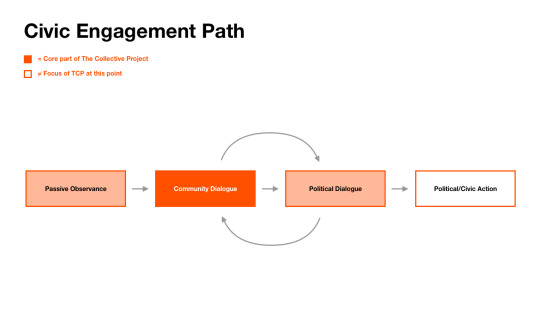
After working on the horizontal path, I realized that it might make more sense as a funnel. Funnels are often used by marketing teams to visualize the steps that an audience takes before converting into a customer. My version applies this idea to civic engagement - showing the steps that many people take before taking political action.
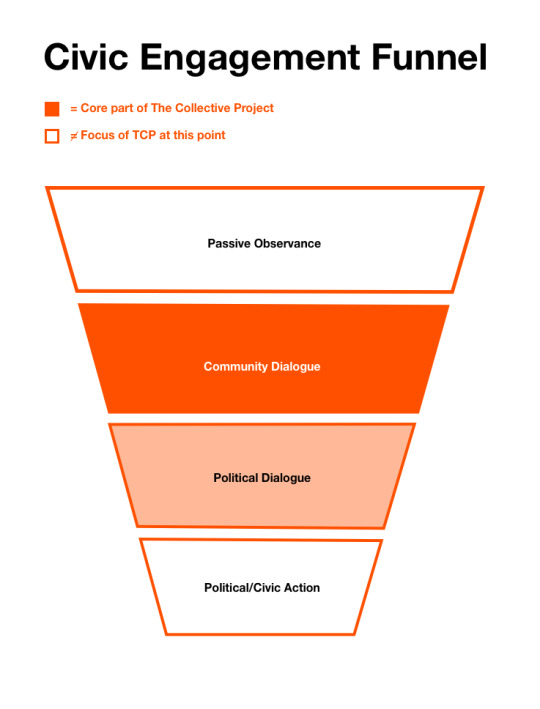
Starting Road Mapping
These maps helped point out the places that I need to explore more and the pieces that feel pretty solid. My next step for these maps was the same as the above, adding detail as to what I know about each of the orange boxes. This helped me form my roadmap for moving forward. After writing all of them down I went back through and highlighted the things that were most important to focus on/dig in to.
Based off of these maps, here are the things that are popping out to me as areas that are most important for me to focus in order of priority:
1. Identifying the mediums (audio/photo) that will be used.
This will help me create exercises that make sense and flesh out a few great examples that are weaved all the way through the curriculum. This will also determine the platforms I need to set up to share student work.
I plan to achieve this by creating/finding examples and writing out draft lesson plans.
2. Developing exercises for core values and identifying advocates.
At least rough exercises will be helpful in order to get feedback/have teachers build off of them.
I plan to achieve this by writing out draft lesson plans and worksheets. I will also prototype these exercises in the classroom.
3. Understanding how educators will use/approach this tool.
How can we make this a collaboration or something that is easily customized? How can educators who use this learn from each other?
I plan to achieve this by getting together with the TFA crew at Great Oaks, reaching out to Hannah and the teachers that I met at IGNITE, and a few of my teacher friends who did not review the last version of this. This is dependent on the two priorities above but is scheduled for the week of Feb 11th to give myself a timeframe.
4. Finding partners.
I need to find partners for amplification and for continuation of the program. Are there orgs that would be interested in rolling this into their existing programming? Are there orgs who will let me test with their students outside of schools?
I plan to achieve this by researching and reaching out via email to orgs/individuals (Mair suggested untapped city or school PTAs) who might be interested in covering/amplifying student work. I also have a list started of organizations in NYC who have similar programming that I can reach out to for possible partnership/testing.
0 notes
Text
Redefining My Concept & Next Steps: AKA All the Drawings
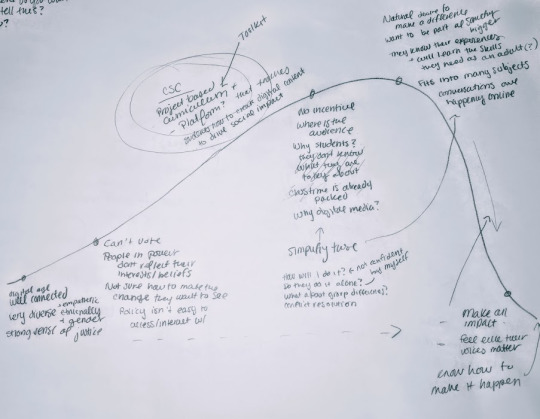
Over the last week, I reflected on what worked/didn't work with the last iteration of CSC, met with my advisor, and dug into research on digital activism. This helped me to start refining my concept statement and clarify changes that need to be made for the next iteration. I haven't had time to make all of my notes pretty, so be prepared. There are a lot of sketches in this post!
Concept Statement/Value Proposition
This week in our storytelling class we started creating concept stories for our projects. The exercise was really helpful to start boiling all of my thoughts down into a clear statement. Above you can see the rough sketch I did in class. Later I sat down to work on creating a few statements based on the story arch exercise. Here are three different drafts:
Quick Note: I no longer like the name Code Switch Club, but for now I will continue using CSC as a shorthand for the project.
For 8th-12th grade students who want to make an impact on their communities but aren't sure where to start, CSC is an educational platform that teaches multi-perspective consideration and digital advocacy 101. Unlike other civic education programs, CSC focuses on storytelling to empower students to organize and tell the stories of their own communities across multiple digital platforms and add to a collective conversation.
CSC is an educational toolkit and platform that teaches multi-perspective consideration and digital advocacy 101 designed for 8th-12th-grade educators who want to incorporate digital media and civic engagement into their curriculum. Unlike other civic education programs, CSC focuses on less on moving straight to traditional tools like petitions and more on the ability of digital media to shape public opinion and facilitate conversation.
CSC is a digital activism toolkit and platform for 8th-12th-grade educators and students that focuses on the impact and future of hyper-local issues. Unlike other civic education programs, CSC can be easily customized for many different curriculums, class lengths, and skill levels.
Updated version from class:
Connected Collective is a flexible civic activism curriculum that utilizes social media to help 8th-12th-grade students discuss the ways their personal experiences are impacted by local policies. Unlike other programs that haven’t been updated for the digital age, Connected Collective uses storytelling to empower students to organize their friends and family online.
User Journies/Life Cycles
One of the big things that Mari encouraged me to do during our advisor meeting was to start mapping out the journies, opportunities, and artifacts for the toolkit/platform. I made several different attempts at this ranging from a more traditional user journey structure to mapping the stakeholder communities and how the different stakeholders impact each other.
For the user journies/cycles, I created one circular chart for the overall lifecycle. This needs to be cleaned up, but it helped me think about how the project could actually have a circular lifecycle rather than a one-and-done workshop effect.

Next, I once again broke the project out into two different user groups: students and teachers. The journey stages for both groups are pretty similar:
Teachers/Facilitators:Awareness > Planning > Teaching > Amplifying > Lasting Effects
Students:Awareness > Learnng > Making > Amplifying > Lasting Effects

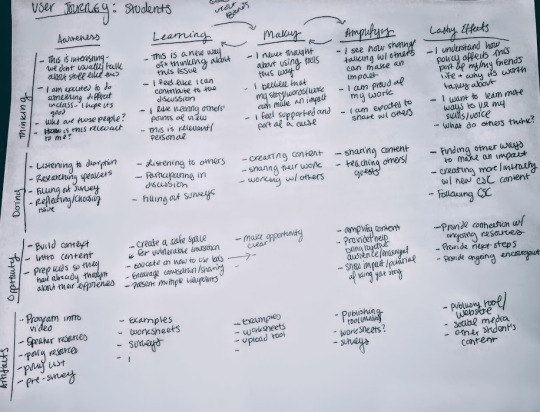
I also started mapping out my stakeholder networks and how CSC influences the network.



Next StepsMy next big step is to create a new teacher's guide that I can send out to get more feedback on and try to get into classrooms! I believe that I can just make this a Google doc as long as it includes links/images of all of the worksheets. Here are the features that will be in the guide:
Program overview
Example campaign (maybe)
Issue Breakdown and suggested local experts
4-5 Activity Lesson Plans
Alternate suggestions/modifications for time and skill level for each activity
A queuing system outlined
Social accounts researched/set up
Mari encouraged me to focus on understanding how educators would interact with the product and try to create something that could be created collaboratively with teachers. With these things done I will be able to test by:
Getting feedback from and collaborate with teachers in my network and with TFA tutors at Great Oaks
Facilitating 5+ days worth of classes in a school (and reach out to schools to do this)
Test the posting process
1 note
·
View note
Text
Reflecting on CSC Version 2

The latest iteration of CSC brought together the insights from talking to Ben, Hannah, Mari, and Kate. I incorporated the ideas of incorporating social media instead of just video and having students focus on particular audiences to communicate with. I also added a day focused on understanding your audience and the idea that CSC could be a platform that amplifies student voices across different social channels. Here are my reflections after presenting the concept to the class and reflecting on feedback.

Overall Feel of CSC Take Two
I feel like while it pulled through the code-switching elements in more obvious ways and focused more on practicing different communication skills, it was actually less promising of an idea. First, I didn't do a great job of thinking through the exercises that would be used to create the social media content. I just said, on this day we will dig into understanding X and we will create Y. It definitely felt less connected and like it was trying to do too much. Second, even though the students were creating more content, I feel that I kind of lost the clarity around reclaiming code-switching as a tool rather than something you have to do to be heard.
Unanticipated Challenges
I don't think I had any big unanticipated successes with this latest prototype, but I did run into several unanticipated challenges:

It was harder than I thought it would be to incorporate social media into the existing curriculum. I thought that it would be simple to change the output of each day to a social medium, but when I actually sat down to write out the lesson plans I realized that each medium almost required a lesson of its own. Doing both a dive into the issue and a medium lesson would be too much to do in one 45 minute period. I'm also not sure how much conversation is needed around the social mediums as the students use them all the time.
This isn't a bad challenge, but Kate invited me to come work with her 8th-grade students at Great Oaks. This is a great opportunity, but the age difference between 8th grade and 10th-12th graders is a huge one. Making the curriculum accessible to this range of ages is a challenge and brings up the need to create options for different age groups. The other challenge that comes with Great Oaks is that the period that I would be working with is only 30 minutes long. That means that I need to think of ways that the days could be cut down or stretched out. This was originally part of my concept, but I haven't really explored this yet.
Student privacy becomes a challenge with social media. While thinking about the different ways to utilize social media I realized that students would have more fun if they could create more of their own content rather than using pre-made things. This is great, but I need to check into the privacy logistics of sharing pictures of minors. Sharing student work usually isn’t a problem, but I’ve seen varying takes on sharing anything that could be identifying a student - especially their face.
One thing that I think I started doing much better was exploring how to explain the concept of the curriculum in a visual way.
User Needs/Personal Needs Matrix
As part of an assignment, I created a matrix to help understand how my ideas thus far have met the needs of my users (students and teachers/facilitators) and my personal goals for my thesis project.

The matrix showed me that although I felt like the execution of the social media version of CSC wasn’t as strong, it actually checked more of the boxes when it came to user/personal needs. This tells me that there is probably something here - I just need to keep working on how to implement it.
Implications for the Project
Through exploring this version of the curriculum I found the following insights:
I need to be careful about celebrating the ability to code-switch without talking about the implications. While calling out code-switching by audience makes a lot of sense and pulls the concept through more neatly across the curriculum it also makes it more important to talk about why code-switching is a thing and the social justice implications of it. Up to this point, I have been dancing around this in the curriculum, but if I continue to focus on code-switching as the method/tool I need to address this more directly.
There is a big opportunity to utilize social media and the power of the collective as a medium. This concept of digital activism also should be addressed head-on if it is going to be used as a tool. It shouldn't just be thrown in as an afterthought. If social media isn't incorporated in a thoughtful and genuine way it loses its meaning and just becomes a communication exercise.
I need to do more thinking about how to utilize the voices/experiences of students and the benefits of social media. In this iteration of CSC, I was having students generate content aimed at specific audiences and then collecting the content to publish later. This process ignores the valuable experiences that the students bring to the table and doesn't foster student ownership. One thing that I could introduce is the group voice of the day. That group would either be the ones to post at the end of the period or be the ones to manage the account for the whole period. Obviously passing off this responsibility is risky, but I shouldn't just talk about how much I value and want to amplify student voices I should actually do it in the moment.
This curriculum very much depends on me or a CSC facilitator. That isn't super scalable. If I want this to be something that other people can run with after graduation I need to think about what the voice/instructions need to be for facilitators that I don't train and finding partners who can carry on the work.
0 notes
Text
Creating a Decision Making Framework

Last night I met with Mari Nakano, the Director of the NYC Civic Service Design Studio. One of the big takeaways from our conversation was that as designers we often want to come up with as many ideas as possible and look at all of them when in reality what we really need to do is focus.
In order to stay focused and help myself make decisions, I am developing a decision making framework based on user needs and my own needs when it comes to my project.
First, some definitions:
User Needs - the basic features or qualities that students, teachers, facilitators and other stakeholders need in order to feel like their interaction with the project was valuable.
Personal Needs - the basic features and qualities that I am looking for as a designer in order to feel satisfied with the project.

Takeaways from this exercise:
All of my users benefit from clarity and from examples. Over the last week, I have heard multiple times that focusing in on one issue at least for the semester/prototypes will simplify things and make it easier for me to build out examples and communicate what I am trying to do.
I need to think about if designing this for public school classrooms is a helpful or limiting constraint. Removing that place constraint may help open up potential partners and allow me to get to testing faster.
I don't want to iterate through different ideas - I just want to test what I have and iterate on it to make it better. I would view my project as unsuccessful if it wasn't tested thoroughly with students.
I'm sure this list could be simplified and will definitely change over time, but this gives me a good reference point to come back to.
1 note
·
View note
Text
Eight Lessons from CSC Initial Feedback

While gearing up for the semester I updated my presentation from the final class into a deck that I could send out to collect feedback. I wrote up a short description of CSC as it stood in December and sent it to a handful of people I had talked to about my project in the past at various stages. So far, I’ve received three responses. I’ll continue to incorporate new feedback, but here are a few of the big takeaways from the first few conversations I’ve had.

1. As a guest or specialist, I should look for and highlight the things that my program can provide that are currently difficult for or not being done already by teachers.
For teachers, especially those teaching core subjects, classroom time is precious. There are standards, specified content that needs to be taught, and an abundance of lesson plan resources out there. That means that bringing in an outside specialist is not something to be taken lightly.
When talking to Benjamin Smith, the Director of Southern Word, an organization I used to work with based in Nashville, and Hannah Weaver, my sister-in-law and middle school English Teacher, this point came up a lot. Teachers get excited about exposing students to opportunities outside the classroom, but those opportunities need to complement and enhance what they are already doing, not just emulate it. For CSC I need to build out and highlight the elements that are new experiences for students and teachers. A few that stood out to those I have talked to so far include:
Coordinating local guests/speakers
Applying the narrative arch to non-fiction
Talking about Code Switching intentionally and respectfully
Incorporating new media in a coherent and thoughtful way and in a context that makes sense
Amplifying student work to larger audiences

2. Teachers are on the receiving end of a lot of training about cultural sensitivity, but there aren’t very many examples of ways they can tangibly incorporate it into their classrooms and curriculums.
This was brought up by Natalie Zwerger, Director of the Center for Strategic Solutions at NYU, and repeated by Hannah and Chad, a current high school teacher. Cultural sensitivity is a big topic right now. Natalie and her team just started a seven-week training course for almost 300 Metro teachers, administrators, and counselors about the topic last week. As our country and our schools become more diverse and the political climate heats up, educators are mindful of changing student demographics and needs. Unfortunately, this is a relatively new focus and is still kind of a buzzword without a lot of examples or programs that exist for teachers to implement in the classroom.
Thinking about finding what CSC uniquely brings to the table, this gap is a great place that CSC could fit into that would be helpful to teachers.

3. Teaching Code Switching is a difficult task and can come off intensively if not done in a thoughtful way.
While nearly all of the educators I have talked to have expressed excitement about the idea of code-switching, I have received some feedback suggesting caution. I think Chad said it best:
"It is a delicate task. If done poorly, then kids can be made to feel like teachers/schools are evaluating their inherent codes/language systems as inferior. "We're going to read this official, properly-written document and then figure out how to translate it into language that folks like you can understand." This is obviously an exaggerated, fictional quote; but you get the picture. When done disrespectfully, Code-Switching is presented as a mechanism by which to dumb language down, and in this way, its lessons feel judgmental, insensitive, racist, etc."
I have also received feedback that code-switching itself can have a negative connotation. Up until recently, I have been trying to avoid this connotation by not addressing it, but when I was talking to Hannah she encouraged me to acknowledge it. She suggested that the concept of the "white people" voice would be something that students would immediately relate to, but it might be better to have that conversation in a small group setting where the discussion would be easier to manage.
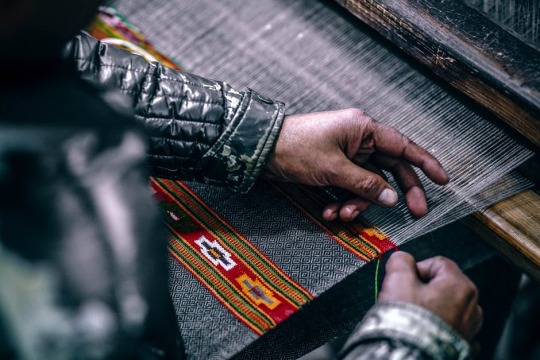
4. Code Switching should be pulled through each day and activity in more intentional and explicit ways.
This was one of the big things that Hannah and I talked about and that I felt was missing at the end of last semester. I knew that I had something with the Code-Switching concept, but I was having a hard time figuring out how to incorporate it all the way through the curriculum. I was essentially just introducing what it was and then diving right into activities without really tying the activities back to the concept of Code Switching.
During our conversation, Hannah suggested having the different groups of students create with a different audience in mind. This would result in the class having four or five different examples of code-switching for different audiences and reinforce the idea that one message can be communicated in many different ways. It would also extend the reach of the student projects. On Day 1 this could be incorporated into the discussion by asking each corner to explain their stance as if they were talking to a different audience. For example, one volunteer would explain the way they felt as if they were talking to a friend walking home from school while another would do it as if they were talking to their parents or an adult family member.

5. I should focus on developing skills as opposed to agenda.
This one is very straightforward. When writing and thinking about learning objectives I should be thinking about what students will be able to do after the lesson instead of what activities they will complete. This is a piece of lesson plan writing that I didn't know before. Hannah encouraged me to think and write this way as teachers care first about what the students will gain rather than the specifics of the activities. Thinking this way would also give me something to measure my activities against.

6. I should look for partners in crime.
One of the questions that people have started to ask is what I would like to do with CSC in the future. I hadn't really thought much about what would happen to it outside of just being my thesis project, but ideally, it would be something that someone could pick up and run with after the spring. Much like Girl Represent, this is something that I could be interested in doing on the side after graduation, but not turning it into a full-time thing. Ben suggested that with this in mind I should look for organizations that already work to bring new media into schools. As a director of an organization like this in Nashville, he said that I could approach organizations with a pitch to trial a new program with them. This would also help me get connected with other "education specialists" and teachers who are already open to these types of programs in their classrooms.
The other suggestion that Ben and others made is to make sure to partner with teachers as opposed to just presenting a classroom takeover. If teachers are involved in the program creation and iteration then they will be more excited and bought into the curriculum and the students will get more out of the experience as well.

7. Code Switching can also be applied to switching between different mediums.
The current iteration of CSC focuses solely on students creating a video at the end of the five days. At different points of time, I had considered using different mediums, but Ben suggested thinking about multiple mediums instead of just one. For example, students could create a bumper sticker, a headline, a tweet, an Instagram post, a snapchat video, and more all communicating the same general message to the same audience. Using these different mediums would incorporate the tools that students are already using and teach them how to use them to communicate a thoughtful, consistent message across platforms. Instead of creating one big deliverable at the end, they could create something each day and then weave them together at the end.
I floated this idea when talking to Hannah and she liked it more than just focusing on the video as well. She thought it would make better use of instructional time and we talked about how the story arch element could still be used by tying each plot point to a deliverable. That way at the end of the week students would have a "campaign" that told a story across different mediums. They would be required to think and reflect on why certain choices made sense for their audience in different applications.

8. Do a few things well, don't try to do all the things.
Lesson planning is hard and one of the rookie mistakes that I made was trying to do too much in too little time. Most classes are 45 minutes long and I wanted CSC days to be able to fit into that structure. However, 45 minutes go by really quickly. Hannah shared that when she was student teaching she would often only be able to cover half of what she had planned. That was similar to my experience at TYWLS. Instead of focusing on the activities, I should focus on what the students will be able to do, create thoughtful activities that achieve those goals, and make sure to leave room for meaningful conversation.
0 notes
Text
Getting Warmed Up Again

It's been cold in New York. Polar Vortex cold. It was also winter vacation and I read a book about a cowboy and watched a lot of television. All of that to say, my brain needed to be eased back into full-time student mode. In class on Tuesday, we did an exercise that focused on getting back into our problem space. Here's what came out of it.
Reiterating and reframing my problem space:
During class, I stated my problem space as elevating the voices of students in their communities. In the last few days though, we've done a lot of the first day of class introductions and I've come to simplify it even further to a larger passion of mine. I like to call it making important s#!* accessible.
You can fill in those letters with whatever you want, but really those two things are what my thesis is all about. To restate it again, because that's how you make things better, I am passionate about making important s#!* accessible and my thesis project is doing that by working with students to talk about policy issues that affect their communities.
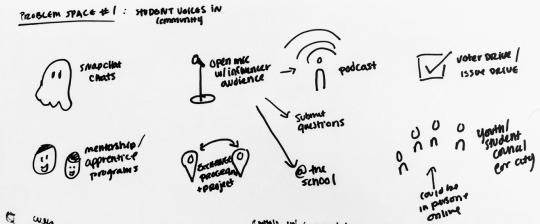
Quick Fresh Ideas
During class, I worked with Wei Ting to go through a quick brainstorming session on both of our thesis topics. We each took a few minutes to sketch out ideas and then shared what we came up with.

The interesting ideas that came out of this session were:
Allowing students to use/create different types of media like Snapchat or podcasts to express how they felt about an issue. Wei Ting also had an idea of projecting or showing student thoughts in a public and interactive space.
Building the audience for the content. Whether that is an audience of their peers or of influencers - creating and curating an audience puts what could just be small projects onto a larger stage and gives them a bigger chance to make an impact.
Doing this more than once with the same group. Whether that means that it is a club that tackles a new topic every week or it is a rotating thing that happens every semester or year, walking the students through the activity more than once would really help develop the way they look at problem-solving across a range of issues.
The Status Quo
I started sketching out the current situation in order to help myself think through the current status quo when it comes to conversations about policy and student voices. Below is what I came up with.

On the top of the sketch, you will find the drivers and expressions of the current status quo. Overall, it is driven by the idea that information that has influence on society is only for elite insiders. This gets expressed in three key ways that I have been looking closely at in my research:
educational standards that tend to ignore policy and civic organization as something to be followed instead of created
the assumption that students don’t know about or can’t handle discussing controversial policies or issues
lack of representation of people who are not white, cis men
the idea that being into policy/civics isn’t “cool”
This status quo is being challenged though. There is building cultural pressure for the status quo to change and address societal tensions including, but not limited to, racial justice, gender equality, wealth imbalance, over policing, student debt, immigration, LGBTQ rights, and many many more.
My thesis project fits into this picture by attempting to facilitate conversations about these societal tensions with students, who are often underestimated and left on the sidelines, and enable students to be active players in dismantling the status quo. Sounds very lofty when I put it that way, but hey, gotta have a driving vision, right?

Looking Forward
What I am Most Excited About
Looking forward to the semester, I am most excited about getting into classrooms and talking to more teachers. I really want to test the curriculum a few times and see what works and what doesn’t.
What I am Dreading
I am dreading trying to figure out where to test it. One of the biggest things I have been dreading/avoiding/struggling with is getting into classrooms. This makes me anxious because I don’t know the school system here very well and so I don’t have a lot of connections. While I don’t mind cold emailing, it is hard to figure out who would be good to work with and get their attention when just emailing out of the blue. In addition, I don’t want to come off as if I am telling teachers how to do their jobs. Teachers get enough of that and I want to make sure I am positioning myself and my project as a partnership and tool rather than a critique.
I am also afraid of people misinterpreting what I am trying to do and taking offense to it. I want the project to be slightly controversial, but I still want to make sure that I am being respectful. I dread making the mistake of trying to be helpful but actually creating something that perpetuates bad models instead of challenging them.
0 notes
Text
December Recap

I thought I had posted the results of my visit to TYWLS, but that post is nowhere to be found! Luckily, I have a version of it saved in 750 Words, but since that was a month ago now I won't repost all of the details. Instead, I'll summarize how the semester wrapped up.
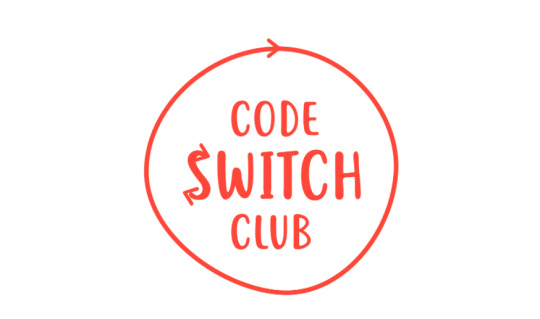
Emergence of the Code Switch Club
The nameless thing finally has a name (for now)! It also has a nice short description. The pressure of putting together a presentation really helps you get a lot of things done.
The current iteration is called Code Switch Club. It is a project-based curriculum aimed at reclaiming the concept of code-switching. It is designed to inspire high school students to learn about, debate, and communicate social justice policies that affect their communities. Over the course of five forty-five minute sessions, students:
are introduced to two sides a tangible issue that affects them or their community, for example where campus sexual assault cases should be handled,
debate how the issues should be handled,
work in teams to identify and understand stakeholders,
create storyboards and story arcs,
create a short video that explains the issue and one proposition for how it should be handled. They will be encouraged to make the information accessible to their friends and community members outside the classroom.

The videos that students create will be screened for other students and administrators and hopefully shared with their friends and family. Over the long-term, the videos would create a library with videos explaining local issues in the voice of the community instead of the legalese usually used by politicians and lawyers. This will help make issues that impact underserved communities accessible to those impacted by them.
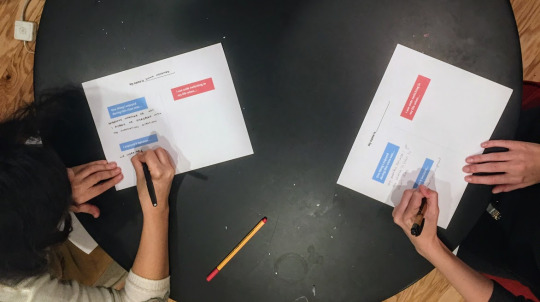
Prototyping Day 1
When I visited TYWLS, I essentially prototyped what Day 1 of CSC would look like. There were around 16 students and I immediately noticed how diverse the class was. I am learning that this is fairly reflective of many metro public schools.
I introduced myself and the project by talking about my experience as a high school student who was really excited to vote but was told that I was ten days too young to have my voice matter in the election. The idea of being in high school and wanting to have a voice was something they could connect with. I framed the rest of my project as an exploration into how teens could get involved and have a voice in the policies that affect them, even if they don't yet have a vote. I also noted that this was a big experiment and that while I wasn't sure what was going to happen, I hoped we would all learn something about the topic and how to talk to each other about our different points of view.
Next, I introduced the concept of code-switching. I asked if any of them had heard the term before. Not one hand. To follow up I asked how many of them spoke multiple languages. About 75% of them raised their hands. Next, I asked how many of them spoke differently when they were talking to their friends versus talking to their teachers. The whole classroom raised their hands. I explained that being able to move between two different languages, or two different ways of speaking, was code-switching. That this was important because policies and politicians often speak a different code than what regular people speak day to day.

With that, I introduced the debate. I explained that t was their job to listen, form their own opinions, and be prepared to discuss. Once the video was over, I asked them to read the three points on the blue side of the sheet and circle one of the options (Strongly Agree, Agree, Disagree, Strongly Disagree) under each. After a few minutes, I asked all of the girls to stand up, read the first point out loud, then asked the girls to move to the corner of the room that lined up with what they had circled on their paper. Most of the students did so confidently while a few just seemed shy. When the groups had settled I went around to each corner and asked for a volunteer to share why they agreed or disagreed with the point. There were girls in every corner, which lead to a great back and forth between the strongly agrees and disagrees.
I wasn't great at managing the clock, but we did manage to listen to both sides. With only a few minutes left in class, I handed out the response sheets and reviewed the concept of code-switching. It was really exciting when I heard students asking each other for clarification and helping each other understand.
Upon reviewing the response sheets, I saw the following patterns:
Students really liked the four corners exercise and having a mini-debate in class. They said they liked it because they could express their thoughts and hear different people's perspectives and because the topic was interesting.
A few liked the activity because they thought it was an important topic they didn't usually talk about at school.
Students were able to get a basic understanding of what code-switching was and give examples of how they would use it.
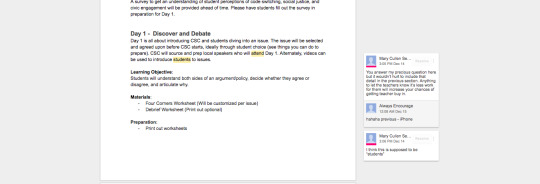
Presenting the Idea and Getting Feedback
The week after my visit to TYWLS I focused on building out the rest of the curriculum. I did this by focusing on creating a teacher's guide for the week. This model forced me to articulate all of the important pieces for each session including:
Materials
Prep
Class Flow
Optional Homework
While writing the content, I used the Talking Trash curriculum guide as inspiration for keeping materials simple and stepping out how the session would flow. For each day I designed worksheets, debrief questionnaires, and found needed online tools. I also went through the guide with my friend Mary Cullen, who formerly taught 9th-grade English. She helped me rearrange some of the information so that important details like what CSC does vs. what the teacher was expected to do were more obvious. She also helped me improve my definitions.
I created my presentation for our final class based on the Teacher's Guide, created a logo (of course), and turned the guide into a PDF. After the presentation, I got some great feedback from the guest critics and my classmates.

So what did I learn?
High school students (or at least these high school students) were able to handle more than I anticipated.
This was a really intense topic. They were able to understand a pretty complicated debate and translate the debate into their own words without too much friction.

The language example and friends vs. teachers examples made sense.
Students also offered their own examples like when they write an essay vs talk to their friends. I haven't used the example of using your "white person voice" but I am curious to see how effective this is.
It is easier to bring this type of program in through an elective or counselor rather than going directly through a core subject. Xenia told me this was the case when she said I could come back in the future. I am curious to see how going through a counselor would be different.
Students really loved the debate.
I wasn't sure if that exercise would go over well, but they were very engaged. Having students stand up out of their chairs seemed to breathe life back into the room and being on the same plane seemed to make the discussion feel more conversational and less lecture-y. It seemed like they really enjoyed sharing their thoughts and opinions, hearing others', and being able to challenge and ask questions of each other.
I need to dig deeper into the concept of code-switching and what it means for people of color who have negative feelings about it.
One of our guest critics called out that code-switching has negative connotations and asked about my intentions with using the phrase. I know how I feel about reclaiming it, but I need to dig deeper into this.
I need to figure out a way to show the breakdown of the days in a more visual way.
I had struggled to figure out how to present them in a Keynote when putting together the presentation. Suggestions from the critics/guests included a diagram and showing more of the exercise sheets.
0 notes
Text
The Final Stretch for the Semester

Our final presentation for the semester is quickly approaching. I feel like I am slightly behind, but I have a good plan to get to the finish line!
The most valuable insights I've learned from the last few weeks:
Entering through core subject classes are going to be a difficult pitch and require more coordination than going for elective classes. That being said, projects with any significant time requirement will need to be coordinated pretty far in advance.
The major difference between middle school and high school is student's ability to work with ambiguity. With middle school much more guidance and explanation is required when it comes to projects and instructions. High schoolers are also more adept at understanding both sides of complex arguments, where middle schoolers are just learning the skills of identifying both sides.
Students in middle and high school are working out their identity and how they fit into the world. This means that policies that address identity issues are easier for them to understand. For girls, policies that revolve around women's rights are also of interest. That being said, policies that have identity components tend to be one-sided in New York. They are often about righting wrongs that most people in New York agree are wrong. This means that it is more difficult than I thought to find people who can present both sides in a meaningful way.
Design and fabrication goals for this week:
Test my explanation of code-switching, video content, and understanding both sides of a complex argument in one class period. (12/5)
Draft a 1-week project plan based off of the success of the above. This will include daily objectives, graphic organizers for unpacking and understanding an argument, storyboarding, and instructions for creating videos (12/10)
Mock-up of what the policy and video libraries could look like (12/12)
A user journey map explaining the process (12/12)
Remaining Challenges:
My test on 12/5 won't show me what is needed for the in-person presentations
Understanding what graphic organizers work/don't work
Not sure if the same process will work across different policies
Plan for tackling challenges - focus only on video presentations of arguments and one policy for now:
Omit the in-person elements for this prototype
Get feedback from teachers on my graphic organizers
Focus only on one policy for the prototype
0 notes
Text
A Big False Start

After my conversation with Hannah, I started preparing to go back to Great Oaks and work with the 8th-grade students there. Kate had let me know the week before that I should be able to come twice in December to observe and work with students. That didn’t quite work out as planned.

Hurry Up and Pause
In preparation, I wrote up a proposal for what I would like to do over the course of two visits, sent it to Kate, and started preparing. I spent several hours one night working out how I was going to introduce myself and my project to the students and drafting a few activities we could do together. I was ready to go!
Then, the day before I was supposed to go to the school, Kate emailed me and said that she didn't have the capacity to help organize my visits this semester. I felt all of the momentum I had built up leave. In the next two weeks, I needed to find a way to prototype my idea with students, hold a workshop ideally with students and teachers, and create a prototype to present to my advisor and class.
Lessons Learned
I believe every time you fall, you fail if you don’t figure out why. Here are the reasons why I think Great Oaks didn’t work out this time;
I was ambiguous with my ask. It wasn’t clear what I was asking Kate to do and what I was going to do to make it easy for her.
I asked for too much. I got excited about the workshop with the students and doing a workshop with multiple stakeholders. This was too big of an ask and merited the response of “not having the capacity.”
I was trying to design collaboratively, but it made me timid. I was afraid to push buttons, but in trying to avoid pushing buttons I made things overly complicated.
Hit the Ground Running
I gave myself the night to freak out, process what I could learn from the experience, then did one thing that I actually know how to do well: cold email. I started by emailing the people I knew who worked with kids. Then I just started researching schools they were connected to and schools close to SVA. I found email addresses of History, English, and Film teachers and sent out emails. Within a few hours, I had a response from an English and Film teacher at The Young Women's Leadership School in Astoria.
Xenia, the teacher that I connected with, was excited and open to me visiting in a short turn around. I was also super excited to connect with her because film was an element of my long-term vision for the projects students could create. The catch was that her students are high schoolers and the school is in Astoria. I knew that going in and I needed a group to work with, so I was excited to talk to her about what her students were working on.
During our conversation, Xenia told me about the film program they have in partnership with Tribeca and how her students are currently working on documentaries exploring different aspects of identity and stereotypes. Groups were tackling topics like being Latina, African-American, an Immigrant, a student-athlete, and sexualization of women. In order to complement what the students were already learning, the age of the students, and the quick turn around, I would need to change the way I was approaching the workshop.

Finding a Subject to Engage
Not sure of the best way to move forward, I started researching policies that had been recently passed in the New York City Council that touched on women's or immigrant rights. I quickly realized that finding an argument with two true sides to it in those areas might be difficult because of the strong blue hold in the city. The best arguments against programs were often budgetary - and that doesn't make for a very exciting discussion.
Luckily, I found a debate that had been filmed tackling the question of whether campus sexual assault cases should be decided by courts or colleges. It presented a great opportunity for code-switching as the debaters were law professors speaking to an academic audience, but were still approachable enough for high schoolers to understand (hopefully). I spent the weekend watching and rewatching the debate, making sure it was okay to cover the topic in the class, and trying to figure out meaningful but not gut-wrenching ways to help the students reiterate what they heard and articulate how they felt about it.
In my quest to find a meaningful discussion format, I tried a few different approaches on for size including:
- Writing a skit explaining the impact of the policy to a friend
- 1, 2, 4, All
- Storyboarding
- Representational crafting
I ended up finding an educational blog called "Minds in Bloom" with a post called "10 Classroom Discussion Techniques" by Kelly Malloy. I was skeptical at first because this blog was written by a fourth-grade teacher (that's a big age difference), but the tactics listed seemed really solid. So, I incorporated one of the exercises called Four Corners. In this exercise, the facilitator hangs up signs that say "Strongly Agree, Agree, Disagree, and Strongly Disagree" around the room. They then read out statements and students move to the corner they identify with. Then the facilitator asks for a volunteer to share why they felt that way.
So, with that exercise in mind, I came up with the following plan:
Hypothesis:
I believe that if students learn how to code switch when it comes to policy, they will be able to understand how it impacts them and be better advocates for their communities.
I will know this is true when students are able to translate policy impacts into their own words and articulate how they feel about it to others.
Objective:
Students will understand both sides of an argument/policy, decide whether they agree or disagree, and articulate why
Methodology:
Start with some ground-setting: What is code-switching (setting examples: professional, school, home)? Why apply code-switching to policy?
Break down the vocab words in the debate video or that a guest might use. Vocab words include due process, neutrality, and adjudication.
Watch the opening argument for courts to decide
Four corners group discussion - Students will receive a hand out reviewing the points made in the video. They will circle "strongly agree, agree, disagree, or strongly disagree" for each point. Signs displaying with "strongly agree, agree, disagree, and strongly disagree" will be put up in four corners of the room. Each point will be read allowed, students will move to the corner that has the side they agree with. One volunteer will from each side will share their opinion.
Watch the argument for campuses to decide
Four corners group discussion round 2
Debrief - On provided sheets, students will write down one thing they enjoyed about the class, why they enjoyed it, and one reason why code-switching is relevant to their lives/projects
I also designed the following worksheet. Wish me luck!

1 note
·
View note
Text
Lessons and Feedback From Hannah

Last week I spoke with my sister-in-law about the latest iteration of my idea. She was a great person to talk to because she was a middle school English teacher for several years before taking a maternity break. She was one of the first people I had explained the current idea to, and I think I did an okay job of explaining it. After listening to my explanation and asking questions, she gave me a few things to think about:

1. Working with a subject like civics or history could be difficult because their curriculum is very time-based.
Eighth graders cover US History, but they do it in broad swaths and cover 200 years of content from the colonists to the civil rights movement. In order to have an effective partnership, I would need to line up the project perfectly with the spot where a teacher is in their curriculum. English classes are a little bit more flexible, but they still have a lot of content to cover and class time is precious. She suggested looking at a different entrance through an elective course or guidance counselor.
2. Core subjects require highlighting standards.
Another reason why she suggested looking for an alternate class/environment to enter through was because of the number of complicated standards that English and History teachers are required to cover throughout the year. She shared with me the research standards that her team had compiled for English curriculum at her school and suggested ways that I could create content to work with them. For example, since the project I was proposing was research-based, she suggested that graphic organizers and instructions should use words from the standards themselves.
3. Middle schoolers need a lot of directions, examples, and guidance.
They are capable of creating amazing things, but they need a lot more guidance than high school or adult students. Many parts of my idea were very vague in the sketches that I showed her. She encouraged me to give students limited options to choose from when it came to topics and forms of expression. Anything I asked them to create would need to be explained and workshopped and, ideally, include examples. She suggested that I structure and provide resources for how students conduct research and if I wanted them to make a music video, I would need to help them think through how to do that. Because of this, the more relatable and tangible the topics I presented students with, the deeper they would be able to go with them.
4. Teachers love outside tie-ins.
I knew this from talking to Daniel Warner earlier this semester, but it was helpful to get this feedback at this point again. I had been (and still might be) debating how to position my idea to teachers. Hannah said that connecting with community members outside of school and applying skills learned in class to things students are passionate about would be an easy sell to teachers.
0 notes